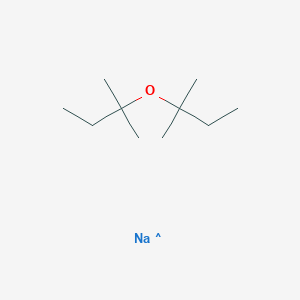
Sodium t-amyl oxide
- Cliquez sur DEMANDE RAPIDE pour recevoir un devis de notre équipe d'experts.
- Avec des produits de qualité à un prix COMPÉTITIF, vous pouvez vous concentrer davantage sur votre recherche.
Vue d'ensemble
Description
Sodium t-amyl oxide is a useful research compound. Its molecular formula is C10H22NaO and its molecular weight is 181.27 g/mol. The purity is usually 95%.
BenchChem offers high-quality this compound suitable for many research applications. Different packaging options are available to accommodate customers' requirements. Please inquire for more information about this compound including the price, delivery time, and more detailed information at [email protected].
Applications De Recherche Scientifique
Organic Synthesis
Sodium t-amyl oxide serves as a strong base in organic reactions, facilitating the deprotonation of weak acids. This property is essential for forming carbon-carbon bonds, which are crucial in synthesizing complex organic molecules. Its role in organic synthesis can be summarized as follows:
Polymer Chemistry
In polymer chemistry, this compound is utilized to synthesize polyolefins, which are essential for producing plastics and elastomers with enhanced properties. Its applications include:
| Application | Description |
|---|---|
| Polymerization | Facilitates the polymerization process to create high-performance materials. |
| Material Properties | Enhances the mechanical and thermal properties of polymers . |
Pharmaceutical Development
This compound plays a critical role in pharmaceutical development by acting as a reagent in the synthesis of drug intermediates. Its applications include:
Analytical Chemistry
In analytical chemistry, this compound enhances the sensitivity and selectivity of assays, making it valuable for quality control processes. Its contributions include:
| Application | Description |
|---|---|
| Assay Enhancement | Improves detection limits and specificity in chemical analyses. |
| Quality Control | Used in various assays to ensure compliance with regulatory standards . |
Environmental Applications
This compound has potential applications in environmental remediation, particularly in breaking down hazardous substances through chemical reactions. Its role includes:
| Application | Description |
|---|---|
| Contaminant Remediation | Utilized to degrade pollutants in contaminated sites through chemical reactions . |
Case Study 1: Organic Synthesis
A study demonstrated the use of this compound in synthesizing complex molecules such as alkaloids and terpenes through deprotonation reactions that facilitated carbon-carbon bond formation.
Case Study 2: Pharmaceutical Development
Research highlighted this compound's effectiveness in synthesizing pharmaceutical intermediates for anti-inflammatory drugs, showcasing its importance in drug discovery and development processes.
Case Study 3: Environmental Remediation
An investigation into the use of this compound for remediating soil contaminated with heavy metals showed promising results, indicating its potential for breaking down toxic substances effectively.
Propriétés
Formule moléculaire |
C10H22NaO |
|---|---|
Poids moléculaire |
181.27 g/mol |
InChI |
InChI=1S/C10H22O.Na/c1-7-9(3,4)11-10(5,6)8-2;/h7-8H2,1-6H3; |
Clé InChI |
UIIJZQVROQHLAP-UHFFFAOYSA-N |
SMILES canonique |
CCC(C)(C)OC(C)(C)CC.[Na] |
Origine du produit |
United States |
Synthesis routes and methods I
Procedure details




Synthesis routes and methods II
Procedure details





Avertissement et informations sur les produits de recherche in vitro
Veuillez noter que tous les articles et informations sur les produits présentés sur BenchChem sont destinés uniquement à des fins informatives. Les produits disponibles à l'achat sur BenchChem sont spécifiquement conçus pour des études in vitro, qui sont réalisées en dehors des organismes vivants. Les études in vitro, dérivées du terme latin "in verre", impliquent des expériences réalisées dans des environnements de laboratoire contrôlés à l'aide de cellules ou de tissus. Il est important de noter que ces produits ne sont pas classés comme médicaments et n'ont pas reçu l'approbation de la FDA pour la prévention, le traitement ou la guérison de toute condition médicale, affection ou maladie. Nous devons souligner que toute forme d'introduction corporelle de ces produits chez les humains ou les animaux est strictement interdite par la loi. Il est essentiel de respecter ces directives pour assurer la conformité aux normes légales et éthiques en matière de recherche et d'expérimentation.














